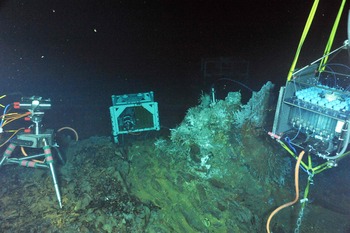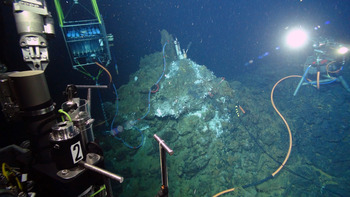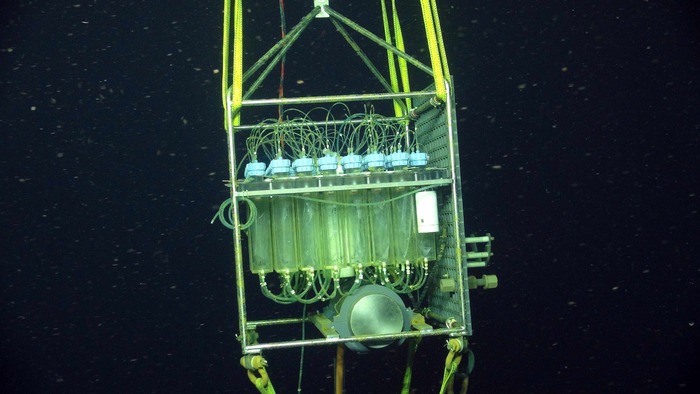
During ROPOS Dive R1729, a digital-still camera (left), a mass spectrometer (middle) and a fluid- and microbial-DNA sampler (right) were installed in the International District Hydrothermal Field at the vent called El Gordo. A titanium "hat" rests on top of the structure in a tubeworm and limpet patch. Inside the "hat" are temperature probes and intake nozzles for the fluid and DNA sampler. Photo credit: NSF-OOI/UW/CSSF; Dive R1729; V14.

The cabled digital still camera streams images of Jason (Dive J2-932) live back to shore in real time as the vehicle works at the active hydrothermal vent called 'El Gordo' in the International District Hydrothermal Field - depth is 1500 m, and >300 miles offshore. The hydrothermal fluid sampler, called the RAS, is shown to the left, which allows fluid samples and temperature to be taken for a year. The instrument can be run in "mission mode" where samples are preprogrammed, or in "sponse mode" where missions are interrupted by operators to take samples - such as was done during the eruption of Axial Seamount in 2015. Credit: UW/OOI-NSF/WHOI, V16.
The RAS (Remote Access Sampler) allows time-series temperature measurement in real-time and in situ sampling of hydrothermal vent fluids, while the PPS (Phytoplankton Sampler) allows filtering and preservation of microbial DNA. Thanks to two-way communication via the cabled network, sample bottles can be triggered from shore in response to volcanic or tectonic events.
The RAS-PPS coupled instruments were first installed in 2014 at the El Gordo actively venting hydrothermal mound in the International District Hydrothermal Field in Axial Caldera. The intake line to the isntruments is placed inside a "vent cap" along with an intake for the mass spectrometer to obtain coregistered temperature, volatile, vent fluid chemistry and micobial DNA analyses at this site. A digital still camera provides an overview of the vent and documentation of changes in vent deposit evolution and macrofaunal communities over time.


